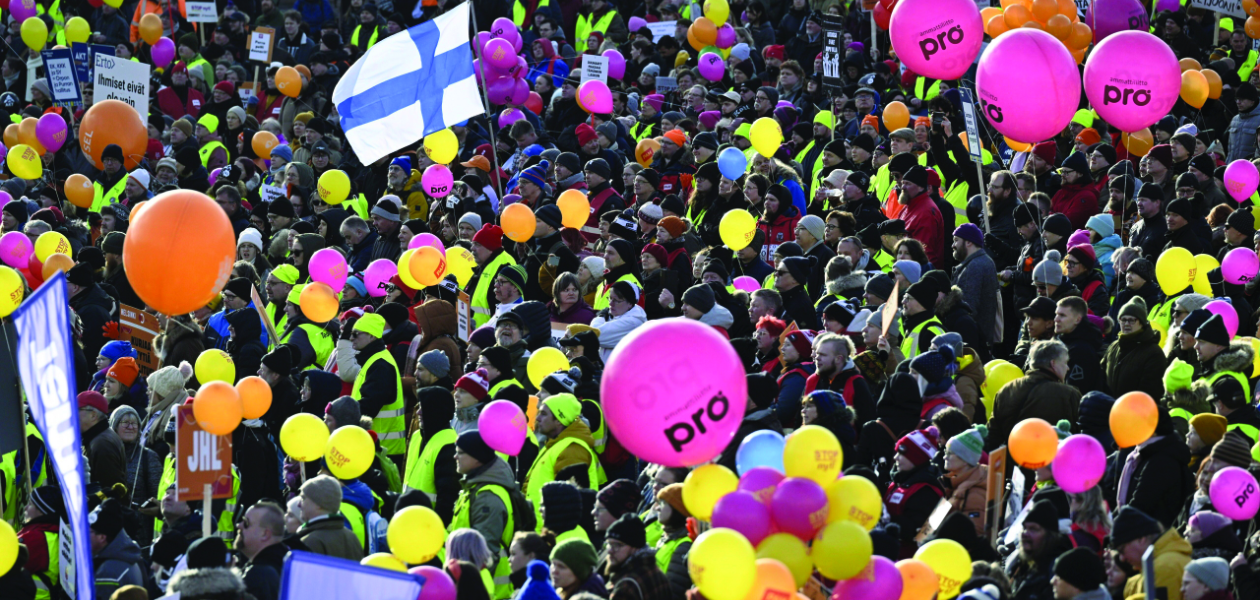
HELSINKI, Finland—Shades of the far-right British Prime Minister Margaret Thatcher more than 40 years ago: After just over a year in office, Finland’s right-wing, pro-NATO Prime Minister Petteri Orpo, a supporter of sending weapons to Ukraine, is trying to bust Finnish unions through wide curbs on workers’ rights.
The Scandinavian nation’s unions have responded with politically oriented general strikes, after realizing that trying to bargain with Orpo’s government is futile. In the United Kingdom during Thatcher’s reign, the Trades Union Congress never even got that chance. The then-weak Labor Party helped little.
With a wide Tory majority in the United Kingdom’s House of Commons, Thatcher easily pushed through a series of measures penalizing any unions that struck, and enacting many other curbs. That’s what Orpo is doing, too. The legislation and the strikes in response were first reported in the U.S. in Harvard University’s On Labor blog
The Finnish strikes, involving whole sectors of workers, began early this year, and were suspended on April 8 for a week, except for strikes already planned, the Central Organisation of Finnish Trade Unions (SAK) announced. The latest round of political strikes sent an estimated 7,000 workers out.
They were members of the Industrial Union, the Finnish Transport Workers’ Union AKT, the Service Union United PAM, the Finnish Construction Trade Union, the Trade Union for the Public and Welfare Sectors JHL, and the Electrical Workers’ Union. They’re still on strike, SAK added.
SAK is “willing to call off the strikes at any time if the government shows some appreciation for the concerns of employees,” SAK President Jarkko Eloranta said. “The executive board will meet again to review the situation and any further continuation of industrial action after Easter.”
This kind of action by labor was unthinkable during the many years of Finish neutrality and refusal to become part of the U.S.-backed NATO block. Finland was known for many of the best social programs in the world. The country openly boasted, for example, of having copied its advanced and free childcare program from the one in place in East Germany before the defeat of socialism in that country, the German Democratic Republic. Now that the U.S.-backed pro-NATO government has taken over workers are fighting to maintain what many took for granted for so many years.
A heavily big-business financed campaign in favor of NATO membership for Finland, when war broke out in Ukraine, contributed to the election of the new right-wing government. The International Trade Union Confederation has a four-word description of the situation in Finland: “Worse than last year.”
“We have sought a fair and moderate approach from the government,” Finnish labor leader Eloranta said in a statement on SAK’s website. Orpo’s government “has turned a deaf ear to employee organizations and is still seeking to implement several industrial policy goals with negative consequences for workers.”
Sympathy strikes curbed
Those “negative consequences” include limiting “sympathy strikes” where one union can strike in support of another and limiting political strikes to 24 hours coupled with high fines against both unions and individual workers who break that limit.
The government’s legislation would virtually junk sectoral bargaining in favor of a combination of local company-by-company bargaining and pattern bargaining, with the industrial exporters setting the “pattern” and actual wage limits, for everyone else.
“Curtailing the right to strike reduces the ability of workers to seek better working conditions. Expanding local collective bargaining is a major deregulation of the world of work that will bring poverty wages and unacceptable terms and conditions to some jobs,” Eloranta observes.
And non-union reps could sign on, on management’s side, to the local contracts, SAK notes. That would set up potential company “yellow unions.”
The union federation adds that Orpo’s government already weakened the nation’s social safety net, “which in turn harms worker bargaining power.” The government reduced jobless benefits, limited financial aid for adult education for unemployed workers, and reduced paid sick leave.
“Last year, the current government…immediately adopted the employers’ decentralization agenda. This has resulted in a policy package tailored to the demands of the main employer and business confederations, and especially to interests of the export-oriented manufacturing industry,” SAK says.
“Many of these goals will have no impact on employment or on the balance of public finances,” the reason the Prime Minister gives for his anti-worker legislation, SAK President Eloranta adds.
Besides the anti-worker legislation, the new right-wing Finnish government pushed “another round of brutal social welfare cuts” through parliament, the union confederation said. Eloranta calculated those cuts, which began April 1, “will plunge an additional 100,000 adults and 17,000 children into poverty.”
“The social welfare cuts are already forcing many people on low incomes to move out of their homes,” Eloranta adds, saying Orpo plans even more slashes “which will visit even greater hardship on ordinary workers.”
A SAK-commissioned public opinion poll in February of 2,500 people found a 51%-42% margin favoring the politically oriented strikes. In a further indication of popular sentiment, some 13,000 Finns jammed a February 1 protest in the main square of the capital city of Helsinki, disregarding both overcast winter conditions and the very short span of daylight.
Finland has long been known for its progressive pro-worker policies, comparable to those of its Scandinavian neighbors, Sweden, Norway, and Denmark. Still, its union density rate fell from 74% in 2000 to 59%–pre-pandemic—in 2019, International Labor Organization data shows. U.S. union density that year was 10.3%, just below the worldwide average of 11.2%.
We hope you appreciated this article. At People’s World, we believe news and information should be free and accessible to all, but we need your help. Our journalism is free of corporate influence and paywalls because we are totally reader-supported. Only you, our readers and supporters, make this possible. If you enjoy reading People’s World and the stories we bring you, please support our work by donating or becoming a monthly sustainer today. Thank you!













Comments